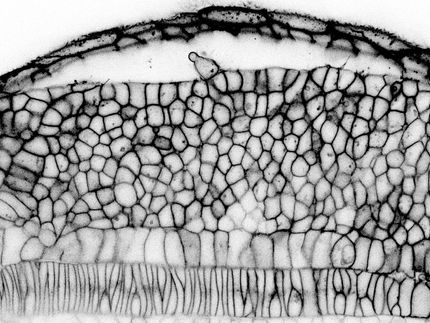The recipe for making a fruit fly
Scientists use mass spectrometry to determine the absolute copy number of nuclear proteins and histone marks
Currently, most if not all of the proteins that are required for constructing a multicellular organism are known. However, it is largely unclear how many copies of each protein species are present and needed to permit an animal to develop into a complete organism. Researchers at the Max Planck Institute (MPI) of Biochemistry have used mass spectrometry to determine the absolute copy number of thousands of different nuclear proteins and several histone marks in fruit flies. This information helps our understanding how the different proteins work together to control the construction of the body of a fly.

Molecular marks and proteins (red) regulate gene activity. Mass spectrometry can determine the identity and quantity of these proteins and marks. The quantity information, similar to a cake recipe, helps to understand how many different proteins are needed for the development of an organism.
© Adapted by designua, thanksforbuying, Adobe Stock
Fruit flies and humans have a lot in common. Approximately 60 percent of the fly genes occur in humans in a similar form. Much insight into basic mechanisms has been gained through research in the fruit fly model. The findings of these studies have provided important information on how these mechanisms work. In the latest study, Jürg Müller from the MPI of Biochemistry together with research groups from Axel Imhof at the Ludwig-Maximilians-Universität (LMU) in Munich and Michiel Vermeulen at Radboud University in Nijmegen investigated the protein set that is needed to generate a fly. They determined the absolute copy number of proteins and chemical marks on histone proteins in cell nuclei from developing fruit fly embryos.
Chromatin is DNA wrapped around so-called Histone Proteins. The entire DNA in the cell nucleus (Genome) contains the information that allows a fertilized oocyte to develop into an organism. Jürg Müller, head of the research group "Chromatin Biology" explains: "The development of an embryo is a fascinating process. Unlike in humans, model systems like the fruit fly allow us to describe this process and to investigate how it is altered in genetically mutated animals. The organization of chromatin changes dramatically as embryonic cells become more and more restricted in their developmental potential. So, we wanted to understand whether and how the abundance of different chromatin proteins and chemical marks on histones change during these critical phases.” The researchers measured the copy number of almost 4000 nuclear proteins and chemical marks on histone proteins during two different stages of embryonic development.
Jacques Bonnet, the first author of the study, says: "One can compare the knowledge that we gained on the amounts of individual protein species to the knowledge that is needed to bake a cake. Knowing that you need to add eggs, sugar, flour, butter, raisins and baking powder does, by itself, not give you a recipe yet – you need to know the exact amount of each ingredient in order to bake that cake. Similarly, we think that to understand the process of embryo development, we need to know how many copies of each protein are present in an embryonic cell".
“Intriguingly, we found that many proteins that regulate development were either much more or much less abundant than one might have assumed. These observations will need to be incorporated into our current view of how chromatin works and some of these views will need to be revised.” Jürg Müller concludes.
Original publication
Other news from the department science
These products might interest you
Most read news
More news from our other portals
See the theme worlds for related content
Topic World Mass Spectrometry
Mass spectrometry enables us to detect and identify molecules and reveal their structure. Whether in chemistry, biochemistry or forensics - mass spectrometry opens up unexpected insights into the composition of our world. Immerse yourself in the fascinating world of mass spectrometry!

Topic World Mass Spectrometry
Mass spectrometry enables us to detect and identify molecules and reveal their structure. Whether in chemistry, biochemistry or forensics - mass spectrometry opens up unexpected insights into the composition of our world. Immerse yourself in the fascinating world of mass spectrometry!
























































